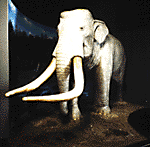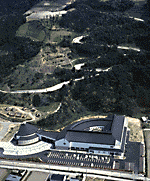Main content starts here.
Introduction to Nagano Prefecture > Prehistoric Times
Updated:February 1, 2023
Prehistoric Times
Prehistoric Times "Shinano people lived close to nature"
The prehistoric era is the longest and oldest era in the history of the Japanese islands dating back to about 600,000 years ago when humans first appeared on the Japanese archipelago.
About 35,000 years ago Prehistoric people living by the shores of Lake Nojiri hunted Naumann elephants and giant deer that had crossed from Asia during the ice age by driving them towards the lake or into the wetlands nearby. They hunted with stone implements such as spears made from obsidian obtained from the area around Wada Pass. They also collected fruit and berries such as hazelnuts and Pinus koriaiensis.
About 12,000 years ago, the climate started to become warmer and the present Japanese archipelago was formed. During this period, Jomon man invented bows and arrows and earthen pottery.
As the earthen pottery allowed food to be cooked, there was an increasing consumption of plants as food, making it possible for people to settle in one place. The area at the foot of Mt. Yatsugatake is often called the "Jomon Kingdom". As many wild chestnut trees and oak trees grew in the area which was also the habitat of many animals, it was an ideal living environment for Jomon man, and about 5,000 years ago it was the most densely populated area of the Japanese archipelago.

Reconstruction of a Naumann elephant (Displayed in Nagano Prefectural Museum of History)
Rice cultivation was introduced into Japan from Asia 2,300 years ago and about 200 years later rice started to be grown in Nagano prefecture.
As production increased, differences arose in the social positions of the villagers until finally disputes started over land and water.
By about the middle of the 4th century, ancient burial mounds, square at the head and rounded at the foot, were built for the powerful men who controlled the region, such as the burial mounds of General Mori (in Koshoku City) and General Kawayanagi (in Nagano City) in the southern part of the Nagano Basin where Yayoi culture flourished.

Burial mound of General Mori and outside view of Nagano Prefectural Museum of History
お問い合わせ
企画振興部広報・共創推進課
電話番号:026-235-7110
ファックス:026-235-7026